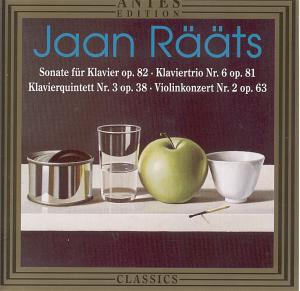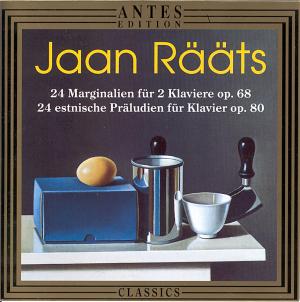Rääts was born in Tartu on 15 October 1932. His training was as a pianist. At the Tallinn Conservatory his teacher was Heino Eller (1887-1970) who is celebrated in another Antes CD reviewed elsewhere on this site. Senior posts with Estonian Radio and TV followed, with these culminating in a professorship at the Estonian Academy of Music.
The sonorous Sonata for Two Pianos is about a dozen years old now. It is pretty clangorous, fury-driven, strongly rhythmic with a jazzy musculature and a slightly peppery dissonance. There are some similarities here with the style of piano music by Kapustin. It is all very approachable like Sondheim in Follies spliced with Reich and Nancarrow.
The Trio is from only the year before. This too drives along but is at first much more fragmented and tough. It soons develops the visceral pounding dynamism that distinguishes the Sonata with its echoes of Reich, Nancarrow, Tippett and Bach.
All of these recordings are close proximity and relatively unsophisticated but completely red-blooded and with fecund abandon. The Quintet suffers a little in relation to the recording which betrays some passing distortion. Otherwise the same Reich-like qualities are there. The last movement allegro is clearly influenced by Shostakovich - wild and fraught.
The Concerto is for violin and chamber orchestra. It is designated No. 2. It reminded me of Schnittke, super-heated Bach, Nyman, Vivaldi and is desperately attractive as is all this music. This would go well in a concert sandwiched between the Tippett Corelli Fantasia and the Schnittke Second Violin Concerto. There are some extraordinary coups in this work which places Rääts as a sort of Estonian 'Red Priest'.
If this disc was simply another reminder of an 'original' then you could pass it by but there is enough ‘true North’ in this music to draw you in. My usual list of influences is there to help you triangulate not to tell you that the music is hollowly derivative. Try it.
There is another Rääts CD from the Antes stable and I shall certainly be reviewing that one.
No sooner the word. ....
The Marginalia and the Estonian Preludes share a means of expression which drinks deeply of the draughts of minimalism, Bach-like vigour, a shatteringly stony piano tone when called for and an unashamed engagement with beauty, They also share a schematic which entails one piece in each set for each of the twenty-four keys. The pieces are shorter in the case of the Marginalia than in the case of the Preludes.
The Marginalia have the marmoreal coldness, shatter and hardness of the Shostakovich Twenty-Four. They also echo with the warming shade of Johann Sebastian Bach. Western listeners will also equate these pieces with the Nyman score for The Piano, with 'chase' music for the silent cinema and with the piano-player studies of Conlon Nancarrow.
The Estonian Preludes are for solo piano. Each is inspired by ancient Estonian runic songs. Ostinato rhythmic material dominates. There is just as much dissonance as with the Marginalia ... well perhaps a shade more. Patterns and little swirls are a commonplace amongst this music. Mix in a dash or two of Shostakovich's grotesquerie and you have very fair idea of Rääts' sound-universe. Perhaps the most subtle work among the forty-eight is the seventeenth Prelude which steps from dreams into a full tilt and no holds barred presto.
My ears tell me that these are analogue recordings. There is nothing to confirm this in writing but assume sturdy ADD sound.
Rääts proves himself the Bachian Estonian minimalist with overtones of Schnittke, Nyman and Kapustin.
Rob Barnett



